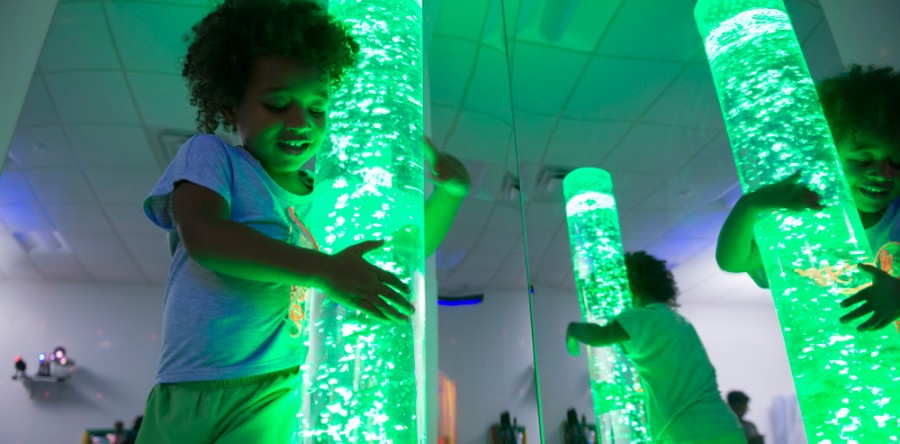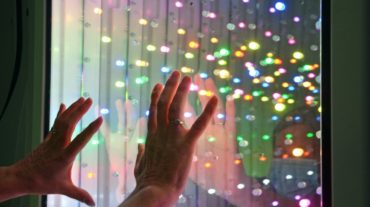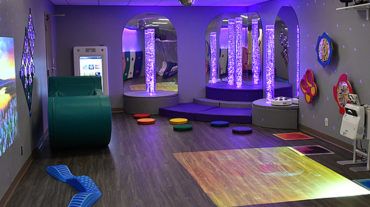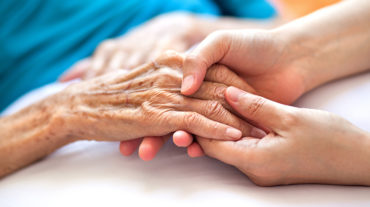By Linda Messbauer
“Virginia” used the Snoezelen Experience to become calmer. She relaxed through the exploration of light and sound and began to rock in the rocking chair in a slow rhythmical pace.
Because of the unique background and history of many of the individuals I serve, and because of the complications stemming from their often complex diagnoses, I would like to share with you, step by step, the route that I take as I approach an individual and invite him or her to try the Snoezelen experience. Please note that although my position paper on this was written in 1998, and some of the material is outdated due to the advancement of the sciences; I feel the basic philosophy and concepts remain current.
MEET “VIRGINIA”
“Virginia” (not her real name) is self abusive. She punches her face or hits herself with a shoe and disrobes, taking off her shirt. She locks her own arms in her shirt at other times. She appears to be in constant motion in her environment. She is either standing or sitting or attempting to lock herself into a corner of the activity room in direct sight of people. She repetitively alternates between sitting in a chair (which she pushes continuously back into a wall), and standing up, rocking, and then sitting again. She will do this hundreds of times throughout the day. She makes lowpitched noises and rocks forward and back. Virginia appears to have no purposeful activity other than to feed herself. She does not smile or make direct eye contact. Her head position is held flexed and towards the side. She gazes up from this position to watch her surroundings. She is hyper-vigilant to her environment and moves quickly when someone approaches. Virginia is a toe walker. “Virginia” is one of our individuals who appears to be in a chronic state of “Fright & Flight & Fight” with “Sensory Defensiveness.”
BEFORE ENTERING THE SNOEZELEN ENVIRONMENT, WHAT INFORMATION SHOULD ONE OBTAIN?
Building a Sensory History: Prior to taking someone into the Snoezelen environment, you must obtain the person’s medical and birth history if possible, as well as current medications, living situation, sleeping, eating habits and behavior patterns. Such information will give you a “whole person-centered picture.” At this point in time, you are not necessarily concerned about diagnosis and clinical opinion. The individual should be observed across as many different environments as possible. The goal is to look for clues to their sensory preferences. You may find clues on the transportation ride, their home and their community at large. Always remember that people tend to function differently in various environments. The idea is to configure the set-up and potential priorities of equipment engagement that would be non-threatening to the individual and coincide with their personal preferences as much as possible. You want to try and ensure as much success on the first visit as possible. You are entering into a journey of trust with the individual that you hope will give them a quality of life of their choosing.
OBSERVATIONS IN THE SNOEZELEN ROOM
Virginia’s behavior on the first session was one of constant motion, with her head position facing down at the floor and her eyes glancing upward in fleeting vigilance to watch her surroundings. She was hitting the side of her face with her shoe and hand. She had kicked off both of her shoes as she entered the room. As the lights were slowly dimmed and the light and sound wall started, she came over to me and stood six inches from my chest, but continued with the described behavior. Virginia stayed in this position for an extended period of time and then side-stepped to look around me at the corner sound and light wall. She turned and sat in the rocking chair for a few seconds. She stood and rocked, but the rocking pace slowed down. And then, she sat down again and crossed her legs. This was repeated six times. Her face slapping had stopped and her arms, which had been held close to her chest, were down, and at her sides away from her body. She finally sat for a prolonged time and made gentle sounds and smiled.
You are entering into a journey of trust with the individual that you hope will give them a quality of life of their choosing.
At the end of this first session, Virginia walked over to a mirror, looked at herself, and then looked around the room with her head up at the projected images rotating on the wall. With each session, Virginia’s behavior has changed and, on the tenth session, she came in and sat right down in the rocking chair, leaving her shoes on. During this session, the rocking chair had been left in the locked position (unintentionally) and Virginia tried five times to reach down and unlock the chair, before a staff member realized what she was attempting to do. Virginia, for the first time, was using purposeful hand function to interact with and make an impact on her environment.
OBSERVING THE FIRST RESPONSE
I watch how a person uses their senses, mood, and overt behaviors. I look to see their first reaction at coming into a room with normal lighting and quiet and the absence of a lot of people. The noise level is very different than they are accustomed to. There is silence. Most of these individuals have had little opportunity to be alone, most came from large institutions. It is very important not to speak to the individual or invade their personal space. The person is allowed to be whoever they are, no instructions are given them and they are not touched.
As I watch the person, I observe their breathing. Is it shallow? Are there any deep breaths, sighs, coughs or hyperventilation? I look to see if they are drooling and the position of the mouth and what the jaw is doing. Are they grinding their teeth? What is their level of excitation? Where are they looking (if at all)? Is there a hypervigilance? Are the eyes darting back and forth, or partially closed in a squint? Are they focused on anything, or are the eyes blank? Is there a stare or is there sparkle? Do they make direct eye contact? What is the quality of their eye contact or other visual behavior?
I also look at the amount of gross movement, or lack thereof. Are they in constant motion, such as pacing or rocking and, if rocking, in what plane or direction? Or are they glued to the ground? I watch their walk and the placement of their feet. Do they seem to know where they are? Are their steps tentative, solid or hard? Do they toe or heel walk? I watch their body tone. Are they rigid or tense? Do they hold their extremities close to their sides or are they out far from their body? I look for their head position in space, and their orientation to the environment. I listen for any vocalizations or sound production. Are they screaming? Humming? And, if so, at what volume level, pitch or tone? I look at their hands and at the musculature. Are they underdeveloped? I look at what they are doing with their hands and how they hold them. Are they using their hands in a self stimulatory fashion? Do they touch themselves, and, if so, is it lightly or with deep pressure or force? I look to see if they tear or remove clothing or shoes. Do they wrap themselves in their clothing? I make no judgements about the behaviors; only that they are happening, and wonder what purpose they may serve the individual.
I am allowing the person to choose through their actions, and configuring the room in line with those choices.
MANIPULATING THE ENVIRONMENT: STARTING TO INTERVENE ACTIVELY
Once I have observed the person’s exploration, I gently start changing the environmental stimuli to see what the effect might be. The room lights are dimmed slowly and soft relaxation music is started along with the corner light wall. The bubble tubes and fiber optic spray are turned on. And, eventually, the projector is engaged with four different rotating patterns projected on the wall. The person is watched to see if any of the equipment is looked at, or if they even move in the direction. The person’s reactions are monitored and the environment adjusted according to the person’s preferences as they are noted. I am allowing the person to choose through their actions, and configuring the room in line with those choices. Often, this is the longest part of the process to figure out: which equipment and music work best for the individual to reach a state of relaxation?
WHAT DID WE FIND OUT ABOUT VIRGINIA?
By looking at her discovery and exploration in Snoezelen, we found that Virginia’s primary sensory preferences are Vestibular (rocking) and Proprioceptive (heavy work) input. She avoids light touch. Virginia used the Snoezelen experience to become calmer. She relaxed through the exploration of light and sound and began to rock in the rocking chair in a slow rhythmical pace. Note that slow rhythmical vestibular input is calming. So, what is next for Virginia? Has there been carryover of reduced challenging behaviors back into the activity room? Not yet, but now, within the Snoezelen room, we can touch her and treat the Sensory Defensiveness by adding “brushing” (an approach/ protocol developed by P. Wilbarger which consists of putting pressure touch into the tactile system by use of a nonscratching surgical brush, and then proprioceptive input into the system through joint compression). Please note that the treatment should be done by individuals trained in Sensory Processing Disorders.
The effect of adding pressure touch is to further calm the over arousal (Fright, Flight or Fight) and help the individual to gain control and set the readiness for further choices in adapted responses. (Functional actions) This is done by enhancing brain stem stimulation. Pressure touch through the skin, stimulates receptors that cause brain stem production of the biogenic amine chemistry, which enhances the parasympathetic system to counteract the sympathetic system and clears stress chemicals.
Has Virginia changed? In the Snoezelen room itself, it reduced her stress and enabled her to function and be happy there. For people with disabilities whose compromised nervous systems don’t allow them to experience peace, Snoezelen helps provide some.
There were other more significant changes. In the beginning, Virginia would never sit down to eat lunch. She was very underweight as a result of this behavior and nursing was also very concerned. After taking her into Snoezelen for several weeks, the result was a permanent change. Virginia continued to make progress after the paper was written. She can now sit and eat in a noisy cafeteria. From being severely underweight, she gained eight pounds and maintained it. She no longer strips off her clothing. She can be touched and will initiate coming to the Snoezelen room when she is in a high state of anxiety or stress. Her sleeping pattern has changed, and she sleeps through the night. Most of all, Virginia is now making choices for herself.
About the Author
Linda Messbauer is one of the world’s leading experts on Multi-Sensory Environments. She has over 30 years experience and was the first person to create a Snoezelen/ MSE room in the United States. her mission is to assist organizations, groups and individuals who wish to utilize Multi-Sensory Environments to provide treatment and quality care to the people they serve. Linda is a recognized International Trainer and Founding member of the American Association of Multi-Sensory Environments.
Originally published in Exceptional Parent Magazine: December 2012
Download the PDF version here





